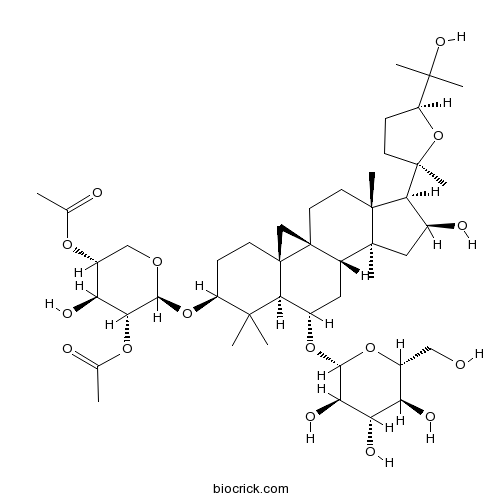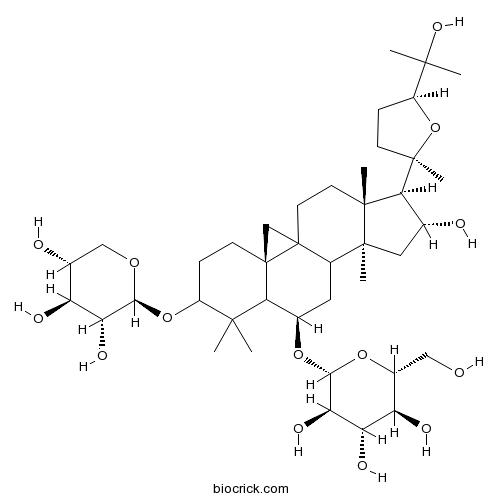Astragalus membranaceus var. mongholicus
Astragalus membranaceus var. mongholicus
1. The products in our compound library are selected from thousands of unique natural products; 2. It has the characteristics of diverse structure, diverse sources and wide coverage of activities; 3. Provide information on the activity of products from major journals, patents and research reports around the world, providing theoretical direction and research basis for further research and screening; 4. Free combination according to the type, source, target and disease of natural product; 5. The compound powder is placed in a covered tube and then discharged into a 10 x 10 cryostat; 6. Transport in ice pack or dry ice pack. Please store it at -20 °C as soon as possible after receiving the product, and use it as soon as possible after opening.
Natural products/compounds from Astragalus membranaceus var. mongholicus
- Cat.No. Product Name CAS Number COA
-
BCN5930
Calycosin20575-57-9
Instructions

-
BCN5931
Calycosin-7-O-beta-D-glucoside20633-67-4
Instructions

-
BCN2918
Pratensein2284-31-3
Instructions

-
BCN1061
Formononetin485-72-3
Instructions

-
BCN2979
Isoastragaloside I84676-88-0
Instructions

-
BCN5962
Astragaloside II84676-89-1
Instructions

-
BCN5960
Astragaloside IV84687-43-4
Instructions

[Analysis on SSR information in transcriptome of Astragalus membranaceus var. mongholicus and its polymorphism].[Pubmed: 29902894]
In order to enrich the library of SSR and provide more powerful tools for molecular marker-assisted breeding in Astragalus membranaceus var. mongholicus, simple sequence repeats (SSR) loci in its transcriptome were searched in 18 040 unigenes (>=1 kb) by using MISA. SSR loci information was analyzed and SSR primers were designed by Primer 3. Furthermore, 110 pairs of primers were randomly selected for the polymorphic analysis on 20 plants collected from different habitats. A total of 5 640 SSRs were found in the transcriptome of A. membranaceus var. mongholicus, distributed in 4 462 unigenes with the distribution frequency of 31.26%. SSR loci occurred every 6 514 bp. Mono-nucleotide repeat was the main type, accounted for as much as 36.72% of all SSRs, followed by tri-nucleotide(32.57%) and di-nucleotide(27.73%) repeat motif. Among all 75 repeat types, A/T(2 026) was the predominant one followed by AG/CT(1 179), AAG/CTT(477). For validating the availability of the SSR primers designed using Primer 3, 110 pairs of primers were randomly selected for PCR amplification. Among them, 97 pairs of primers (88.18%) produced clear and reproductive bands. Using 19 pairs of primers showed polymorphism, 20 plants were divded into two groups by UPGMA. There are numerous SSRs in A. membranaceus var. mongholicus transcriptome with high frequency and various types, this will provide the abundant candidate molecular markers for genetic diversity, molecular identification, and marker-assisted breeding study for this plant.
Improved bioautographic assay on TLC layers for qualitative and quantitative estimation of xanthine oxidase inhibitors and superoxide scavengers.[Pubmed: 29216590]
A new agar-free bioautographic assay for xanthine oxidase (XO) inhibitors and superoxide scavengers on TLC layers was developed and validated. Compared to the first version of TLC bioautographic agar overlay method, our bioautographic assay greatly improved the sensitivity and quantification ability. The limit of detection (LOD) of this assay was 0.017ng for allopurinol. Quantitative estimation of XO inhibitors and superoxide scavengers was achieved by densitometry scanning, expressed as allopurinol equivalents in millimoles on a per sample weight basis. This assay has acceptable accuracy (95.37-99.23%), intra-day and inter-day precisions (RSD, 2.56-6.69%), as well as intra-plate and inter-plate precisions (RSD, 2.93-9.62%). Six pure compounds and three herbal extracts were evaluated for their potential XO inhibitory and superoxide scavenging activity by this bioautographic assay on TLC layers. Four active components were separated, located and identified in Astragalus membranaceus var. mongholicus extract by the bioautographic assay after TLC separation. The developed method is rapid, simple, sensitive and stable for screening and estimation of the potential XO inhibitors and superoxide scavengers.
[Investigation on Main Cultivation of Astragalus membranaceus var. mongholicus and Commercial Specifications Grades].[Pubmed: 27352529]
To investigate the main cultivation areas of Astragalus membranaceus var. mongholicus, and to clarify its present cultivation status and commercial specification grades.


